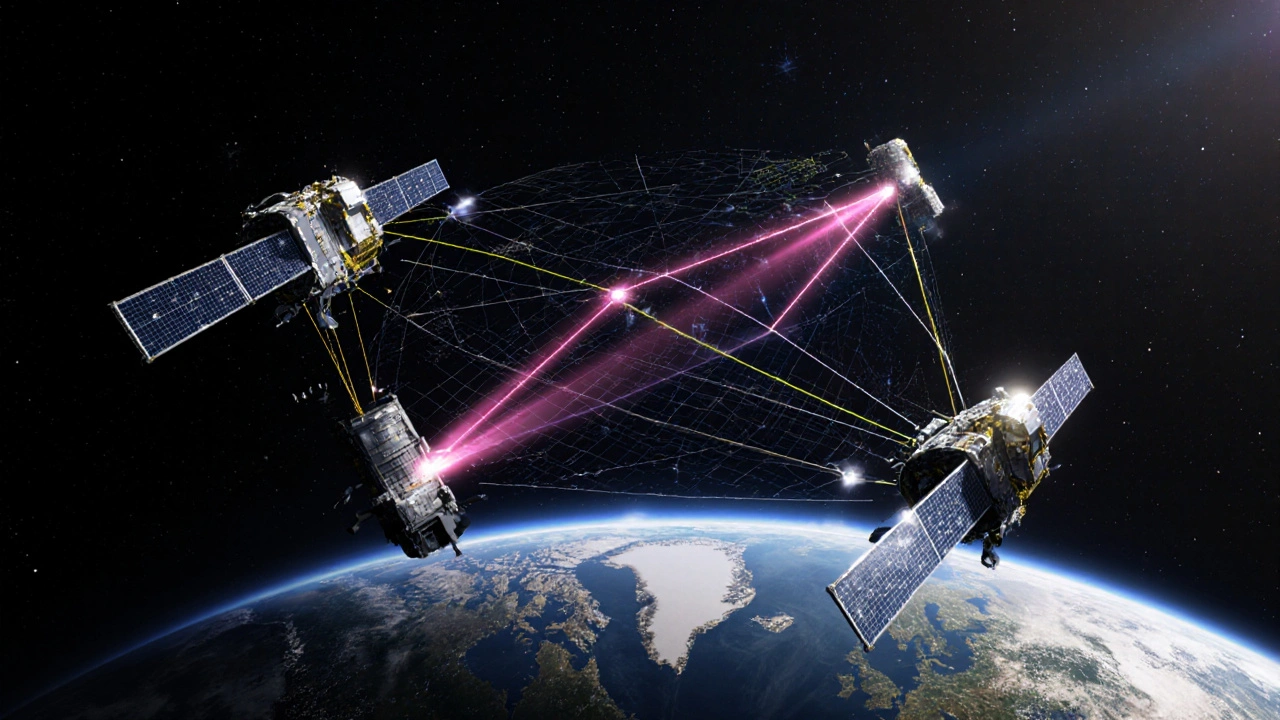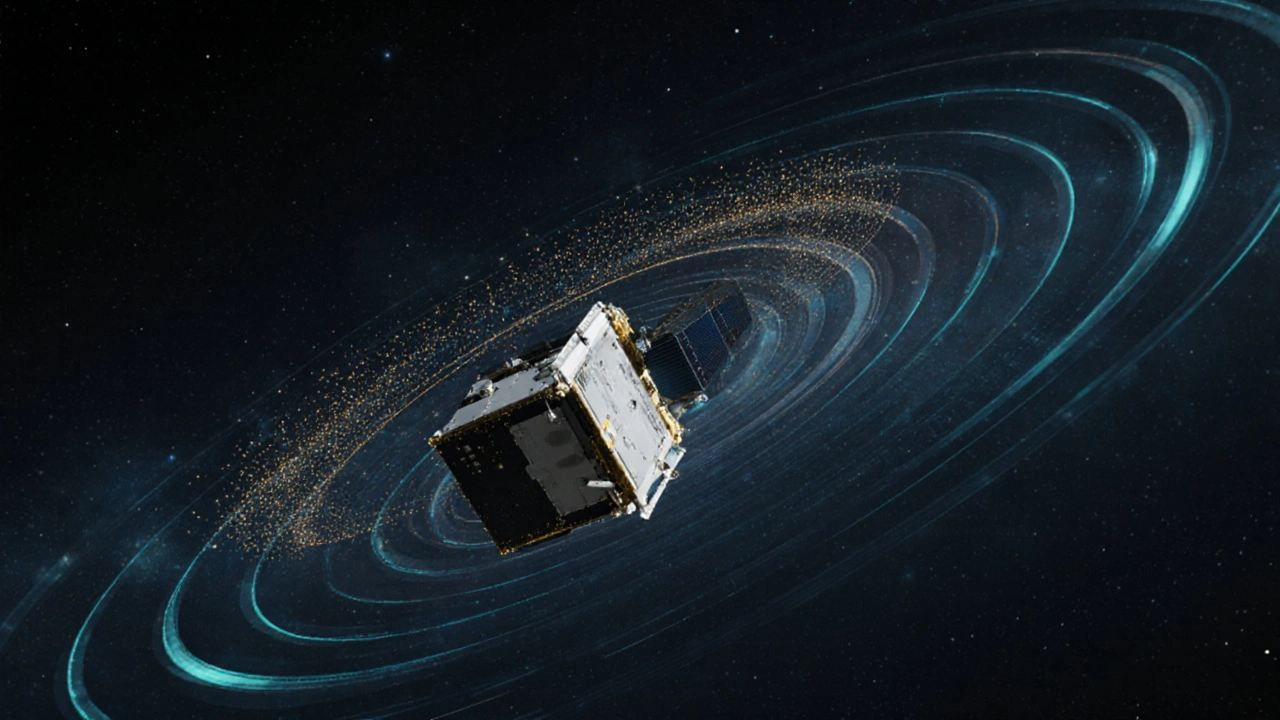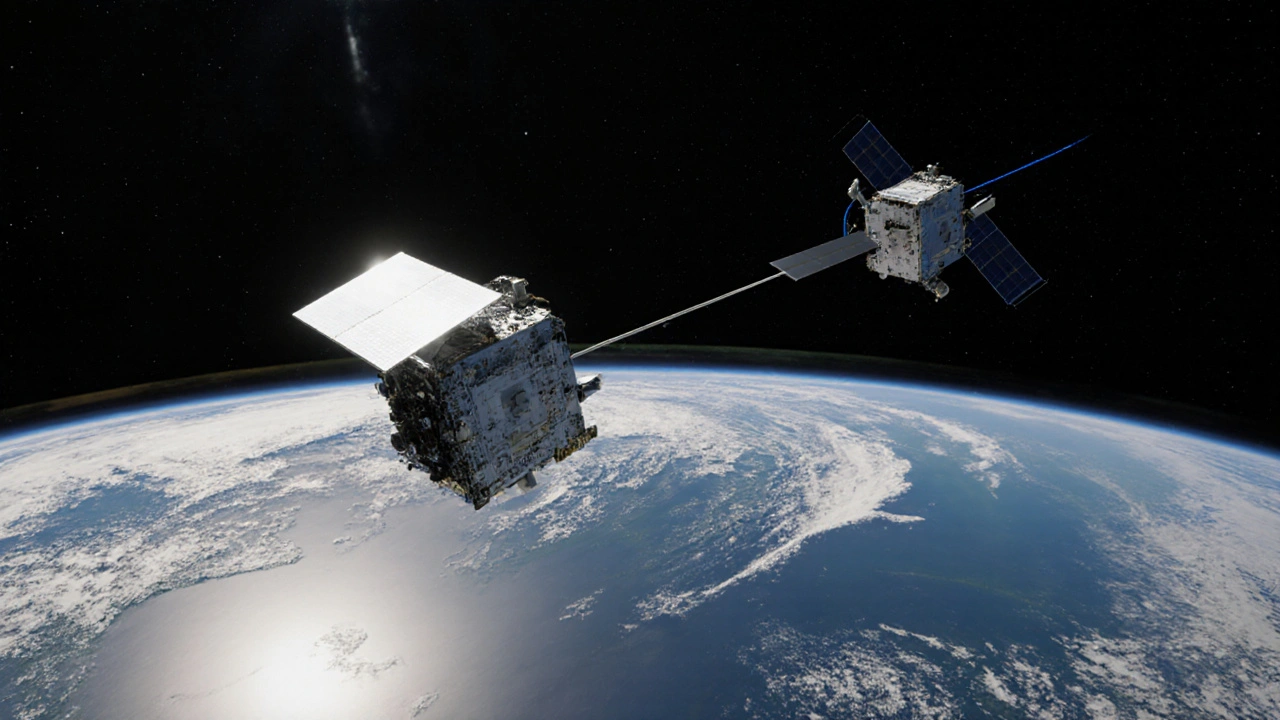What Are Formation Flying Satellites?
Formation flying satellites aren’t just multiple satellites flying in the same orbit-they’re a coordinated team, moving together like a single instrument with precision that borders on the impossible. Imagine two spacecraft separated by just 150 meters, holding position within a few millimeters of each other while orbiting Earth at 27,000 km/h. That’s not science fiction. It’s what missions like ESA’s PROBA-3 is a European Space Agency mission launching in late 2024 designed to demonstrate centimeter-level formation flying for solar coronagraphy are built for. These missions replace massive, single telescopes with smaller satellites that work together to simulate a giant lens or antenna. The result? Higher resolution images, more accurate gravity measurements, and the ability to study phenomena no single satellite could ever capture.
Why Not Just Build One Big Satellite?
Launching a single, giant telescope or antenna into space sounds logical-until you realize how heavy and expensive it is. A 1-kilometer-wide space-based interferometer, like NASA’s proposed Terrestrial Planet Finder was a conceptual space telescope mission designed to detect Earth-like exoplanets using interferometry, would weigh thousands of tons and require a rocket bigger than anything ever built. Formation flying sidesteps that problem. Instead of one massive structure, you launch two or more smaller satellites that fly in tight formation. Their combined data creates the same effect as a single giant instrument. This approach cuts launch costs, reduces risk, and allows for upgrades. If one satellite fails, you don’t lose the whole mission-you just replace the faulty unit.
How Do They Stay in Formation?
Keeping satellites aligned isn’t like driving cars on a highway. In space, tiny differences in gravity, atmospheric drag, and solar radiation push each satellite in slightly different directions. Even a 0.001-degree difference in orbital inclination can cause satellites to drift apart by over a kilometer in a single day. That’s where relative navigation is the process of measuring and estimating the position and velocity of one satellite with respect to another in a formation comes in. Systems like the VISNAV an optical navigation system developed at the University at Buffalo that uses LED beacons and position-sensing detectors to achieve sub-centimeter accuracy use light signals between satellites to track their positions down to 1 centimeter. Others, like the K-band Microwave Ranging a radio frequency system used in GRACE and GRACE-FO missions to measure distance between satellites with micrometer precision, send microwave pulses back and forth, measuring how long they take to return. These systems feed data into control algorithms that fire tiny thrusters to correct drift before it becomes a problem.

Autonomous vs. Ground-Controlled Systems
There are two main ways to manage formation flying: letting the satellites do it themselves, or relying on ground stations. The GRACE-FO a NASA-German Aerospace Center mission launched in 2018 to measure Earth's gravity field using microwave ranging between two satellites mission uses ground control. Operators on Earth analyze data every few months and send commands to adjust the satellites’ orbits. It’s reliable but slow. Meanwhile, missions like TanDEM-X a German Earth observation satellite pair launched in 2010 that flew in close formation to create a 3D map of the planet's surface are fully autonomous. The secondary satellite calculates its own corrections, fires its thrusters, and adjusts its path without waiting for Earth. This reduces delays and allows faster reconfiguration-critical for missions that need to respond to sudden events like volcanic eruptions or earthquakes. But autonomous systems are harder to build. They need robust software, fault detection, and backup systems. One GPS signal loss, as happened in the 2006 PRISMA a Swedish technology demonstration mission that tested formation flying and rendezvous techniques in low Earth orbit mission, caused a 1.2 km separation and took 47 days to fix.
Optical vs. Radio Navigation: The Trade-Offs
Choosing the right sensor system is one of the biggest design decisions. Optical systems like VISNAV offer incredible accuracy-down to 1 cm-but they’re blind when the Sun is in their line of sight. That means they lose signal for 30-40% of each orbit. Radio systems like K-band microwave ranging work day and night, rain or shine, but their accuracy is 10 to 100 times worse. NASA’s 2021 GNC requirements document shows optical systems need 20-50% less fuel to maintain formation, but they limit how much the satellites can tilt or rotate. If you need to point a camera at a fast-moving target, that’s a problem. For missions like Swarm an ESA mission launched in 2013 to study Earth's magnetic field using three satellites in different orbits, which fly 150 km apart and don’t need millimeter precision, radio systems are perfect. For Darwin a proposed ESA mission to detect exoplanets using infrared interferometry with satellites flying within 500 meters, where you need micrometer-level alignment, optical is the only option.
The Hidden Problem: Attitude and Position Are Linked
Most people think of satellite formation as just about position. But here’s the catch: if a satellite’s orientation (attitude) is off by just 1 degree, it can throw its position off by over 17 meters at a 1-kilometer distance. This is called coupled translational-rotational dynamics. It’s why systems like those developed by Dr. John Crassidis at the University at Buffalo use advanced observers that estimate both position and attitude at the same time. Without this, even perfect distance measurements won’t help. The unscented Kalman filter a nonlinear estimation algorithm used in satellite navigation to handle complex dynamics with higher accuracy than extended Kalman filters has become the go-to tool for this, reducing position errors by 41% compared to older methods in formations larger than 1 km. Stanford’s DWARF a project at Stanford University that used GPU acceleration to achieve 10 Hz real-time relative orbit determination for satellite formations even uses graphics processors to run these calculations at 10 times per second-faster than most smartphones refresh their screens.

What Goes Wrong? Common Failure Modes
Even the best systems can fail. One major issue is the zero-crossing problem a condition during formation acquisition where relative velocity approaches zero, causing control systems to lose stability and fail to close the gap. When satellites try to close in on each other, their relative speed drops to nearly zero. At that point, thrusters can’t respond fast enough, and the satellites overshoot or stall. According to Goddard Space Flight Center data, this causes 37% of all formation acquisition failures. Another sneaky problem is helical drift a slow, spiral-like drift in satellite formations caused by small differences in orbital nodes, leading to 500-meter oscillations over weeks. Seen in TanDEM-X operations, a tiny 0.01-degree difference in orbital node angle creates a spiral pattern that grows over time. Then there’s solar pressure-sunlight pushing on the satellites’ surfaces. In 2021, JPL found this causes unmodeled accelerations of 1.2 mm/s² in flat, symmetrical satellites. That’s enough to throw off a formation over days. And don’t forget GPS. In 17% of formation scenarios, differential ionospheric delays make it impossible to resolve carrier-phase integer ambiguities, which are essential for high-precision positioning.
Cost, Risk, and the Future
Formation flying adds 18-25% to mission costs, but it unlocks 40-300% more science capability. NASA estimates it saved $2.1 billion by using formations instead of building monolithic space telescopes. Commercial companies like SpaceX use formation flying too-82% of all formation missions launched by 2023 were Starlink satellites-but they don’t need precision. Science missions are where the real innovation happens. ESA’s PROBA-3, launching in late 2024, aims for 1 mm accuracy at 150 meters using laser metrology. NASA’s StarBurst mission, planned for 2027, will test real-time microwave ranging with 0.5 mm precision. Experts like Dr. F. Busetti at ESA predict 90% of future science missions will use formation flying by 2035. But there’s a catch: the closer satellites fly, the higher the collision risk. NASA’s Conjunction Assessment Team reports 3.7 close approaches per year for formation flying satellites, compared to just 0.2 for single satellites. New UN guidelines now require 99.99% collision avoidance confidence for formations under 100 meters. That’s why robotic servicing, like DARPA’s RSGS program launching its first demo in 2025, could be a game-changer. Imagine a robot fixing a satellite mid-formation instead of launching a whole new one.
Where Do We Go From Here?
Formation flying isn’t just a niche technology anymore-it’s becoming the standard for high-precision space science. The future belongs to autonomous, optically guided systems that can reconfigure on the fly, handle failures without human help, and work in tight formations without colliding. But the path forward isn’t easy. We need better sensors, smarter algorithms, and more robust fault protection. It’s not just about flying satellites together. It’s about making them think, adapt, and survive as a team. And that’s the real challenge.


12 Responses
Honestly, if we're just gonna launch dozens of tiny satellites to mimic one big lens, why not just build a better ground telescope? We're spending billions to avoid gravity when we could just fix our atmosphere.
This is actually one of the coolest things happening in space right now. The idea that we can make satellites work like a single instrument without having to launch a giant monster is genius. It's like building a choir instead of one opera singer with a megaphone.
You wrote 'PROBA-3 is a European Space Agency mission launching in late 2024 designed to demonstrate...' - that's a run-on. It should be two sentences. Also, 'centimeter-level formation flying for solar coronagraphy are built for' - subject verb agreement fail. Fix your grammar before posting.
Formation flying is the future. We're not just launching satellites anymore, we're building space teams. Think of them like ants working together - no single ant is strong, but together they move mountains. That's what this is.
The article contains numerous grammatical inaccuracies, improper punctuation, and inconsistent capitalization. Furthermore, the term 'K-band Microwave Ranging' is incorrectly presented without proper hyphenation. Such sloppiness undermines the credibility of the entire technical argument.
They say it's for science... but what if this is just a cover for military surveillance? Ten satellites flying in perfect formation? That's not science - that's a drone swarm. And why do they keep mentioning NASA and ESA? Who owns the data? Who controls the AI? Something's off.
It is important to note that the notion of formation flying satellites, while seemingly innovative, is fundamentally predicated upon a series of highly contingent and non-robust assumptions regarding orbital mechanics, sensor fidelity, and propulsion reliability. Moreover, the assertion that replacing a single monolithic telescope with multiple smaller units reduces risk is demonstrably flawed, as the probability of systemic failure increases exponentially with the number of interdependent components. One must also consider the ethical implications of deploying autonomous systems capable of self-correction in orbit, where human oversight is deliberately minimized - a dangerous precedent indeed.
The part about coupled translational-rotational dynamics really hit me. I never thought orientation could throw off position by 17 meters. That’s wild. It’s like trying to walk in a straight line while spinning - you’d end up somewhere totally different. Makes you appreciate how hard this all is.
So let me get this straight - we’re spending billions to keep satellites within a millimeter of each other while they’re moving at 27,000 km/h, but we can’t fix the broken GPS system on our phones? This isn’t progress, it’s a glorified engineering vanity project. The real problem is that we’re funding space porn instead of solving climate change. You’re all just playing with toys while the planet burns.
There is a quiet tragedy in this pursuit - we seek to replicate the unity of nature through artificial means. The stars do not fly in formation. They drift. They exist. We, however, cannot bear the silence of randomness. So we bind them with algorithms, with thrusters, with light. But what have we lost in the need to control?
I love this so much! The fact that we’re using GPU-powered real-time orbit determination at 10 Hz? That’s insane! Stanford’s DWARF project is basically running satellite navigation like a video game engine - and it’s working! We’re not just exploring space anymore, we’re simulating it, optimizing it, making it dance. This is the future of space, and it’s beautiful!
The most impressive part is how these satellites handle solar pressure without human input. That’s not just engineering - that’s adaptability. We’re creating systems that can survive in chaos without blinking.